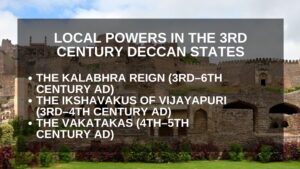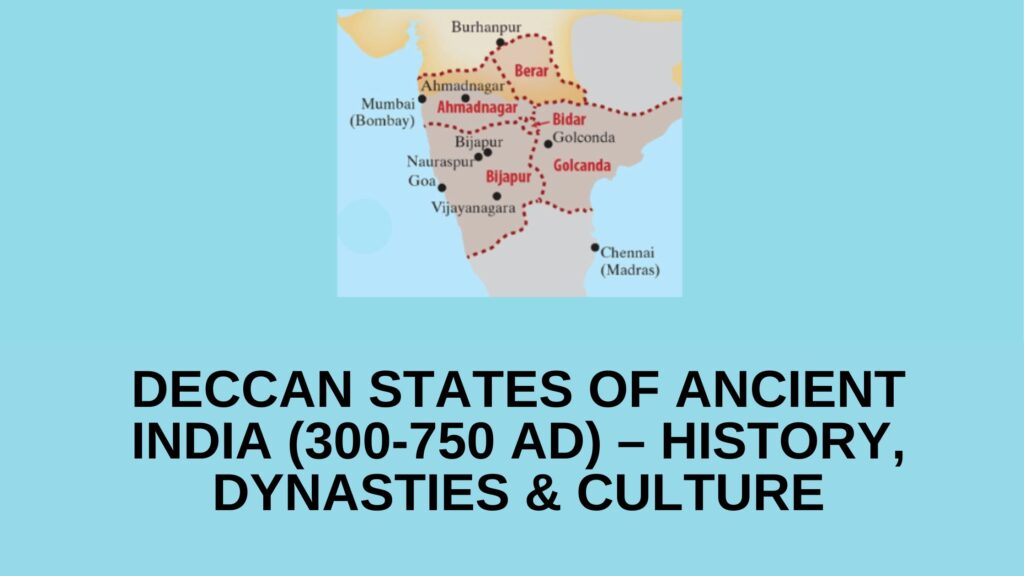The period between 300 and 750 AD was a transformative phase in Indian history, marked by the rise and fall of several regional powers in the Deccan states. Following the decline of the Kushanas in the north and the Satavahanas in the south, numerous minor dynasties emerged, each contributing to the political and cultural landscape of the time.
This era witnessed the dominance of the Guptas in the north and the subsequent rise of the Pushyabhutis, while the Deccan saw the emergence of powerful regional kingdoms such as the Chalukyas, Pallavas, Kadambas, and Gangas.
The Political Landscape
North of the Narmada: Gupta and Pushyabhuti Influence
The Guptas dominated northern India until the 5th century CE, followed by the Pushyabhutis in the 7th century. These northern dynasties maintained control over the political affairs in the region, impacting the developments in the Deccan as well.
Download notes of Megaliths: Exploring the Megalithic Culture, Period, and Age
South of the Narmada: Rise of Regional Powers
In the south, power transitioned through several dynasties, including the Ikshavakus, Abhiras, Pallavas, and Chalukyas. The Sangam-age dynasties (Cholas, Pandyas, and Cheras) declined, paving the way for the Pallavas to rise as a dominant force.
Local Powers in the 3rd Century Deccan States

The Kalabhra Reign (3rd–6th Century AD)
After the decline of the Cholas, Cheras, and Pandyas, the Kalabhras took control of Tamil lands. Described as ‘evil rulers’ in Sangam literature, their rule was marked by a revolt against Brahmanical traditions. They ended Brahmadeya land grants to Brahmanas but patronized Buddhist monasteries. Their rule lasted for two centuries before being overthrown by the Pallavas and Chalukyas in the 6th century.
The Ikshavakus of Vijayapuri (3rd–4th Century AD)
Rising from the remnants of the Satavahanas in the Krishna-Guntur region, the Ikshavakus promoted both Brahmanism and Buddhism. Their rule is evident from archaeological findings at Nagarjunakonda, which showcase both Buddhist and Brahmanical monuments. The Ikshavakus were eventually supplanted by the Pallavas.
The Vakatakas (4th–5th Century AD)
Following the decline of the Satavahanas, the Vakatakas emerged as a significant power in northern Maharashtra and Vidarbha.
Origins and Expansion
Founded by Vindhyashakti (250-270 CE), the Vakatakas initially controlled the Vindhya region. Under Rudrasena, they grew in strength but faced setbacks due to Samudragupta’s campaigns. Following these conflicts, they expanded southward, establishing two branches: one at Nagardhan (near Nagpur) and another at Vastugulma (near Ajanta).
Relations with the Guptas
Chandragupta II cemented ties with the Vakatakas through marriage, giving his daughter Prabhavatigupta to King Rudrasena. This alliance secured Vakataka support against the Shaka Kshatrapas. After Rudrasena’s death, Prabhavatigupta acted as a regent, effectively bringing Vakataka affairs under Gupta influence.
Cultural Contributions
The Vakatakas played a crucial role in spreading Vedic culture to the Deccan while allowing Buddhism to flourish. Several chaityas and viharas in Ajanta caves were constructed under their patronage.
Local Powers (5th Century AD Onwards)
The Kadambas (4th–5th Century AD)
Founded by Mayursharman in the 4th century, the Kadambas established their capital at Vaijayanti (Banavasi). They initially resisted Pallava rule but later accepted their suzerainty. Mayursharman is credited with performing eighteen Ashvamedha yajnas and granting numerous villages to Brahmanas.
The Gangas (4th Century AD Onwards)
Ruling southern Karnataka, the Gangas were often feudatories of the Pallavas. Distinguished as the ‘Western Gangas’ to differentiate them from the later ‘Eastern Gangas’ of Kalinga, their capital at Kolar benefited from local gold mines.
The Pandyas’ Resurgence
After being overthrown by the Kalabhras, the Pandyas re-emerged in the 6th century under Kadungon. Their heartland lay around the Vaigai river basin, with the Kaveri river marking the boundary with the Pallavas.
The Chalukya-Pallava Rivalry (6th Century AD)
From the mid-6th century, the Chalukyas of Badami and the Pallavas of Kanchipuram vied for supremacy in the Deccan.
The Chalukyas of Badami
- Pulakeshin I (543–566 AD): Established the Chalukya empire with its capital at Vatapi (Badami).
- Pulakeshin II (609–642 AD): The most notable Chalukya ruler, known for resisting Harsha Vardhana’s northern expansion and conquering Vengi, which led to the rise of the Eastern Chalukyas.
- Vikramaditya I (655–680 AD): Attempted revenge on the Pallavas but failed.
- Vikramaditya II (733–745 AD): Successfully defeated the Pallavas, marking the decline of their power.
- Kirtivarman II (746–753 AD): The last ruler of the Chalukyas, defeated by the Rashtrakutas under Dantidurga.
The Pallavas of Kanchi
- Simhavishnu (Mid-6th Century AD): Established Pallava dominance by expelling the Kalabhras.
- Mahendravarman I (600–630 AD): Expanded the kingdom but lost territory to Pulakeshin II.
- Narasimhavarman I (630–668 AD): Avenged his father’s defeat by destroying Vatapi and defeating Pulakeshin II.
- Nandivarman II (731–795 AD): Witnessed Pallava decline, with Kanchipuram briefly occupied by the Chalukyas.
Cultural and Administrative Contributions
Temple Architecture
Both the Chalukyas and Pallavas contributed significantly to temple architecture.
- Chalukyas: Developed the Vesara architectural style, seen in the Pattadakal group of temples (now a UNESCO site).
- Pallavas: Constructed rock-cut and structural temples, including the famous Shore Temple at Mahabalipuram and the Kailasanatha temple at Kanchipuram.
Download notes of Tripartite Struggle
Administrative Systems
- Chalukyan Administration: The king was the supreme authority, supported by officials. Villages were administered by mahajanas, with a leader called Gavunda.
- Pallava Administration: Organized into Nadus (districts) and relied heavily on local assemblies, including Ur (non-Brahmanical villages), Sabha (Brahmana-dominated villages), and Nagaram (merchant assemblies).
The period from 300 to 750 AD was one of political flux in the Deccan, marked by the rise and fall of regional dynasties. The Chalukya-Pallava conflict defined much of the later period, influencing not just military history but also cultural and architectural advancements.
These dynasties laid the groundwork for the future political and cultural developments in South India, leaving a lasting legacy on Indian history.


